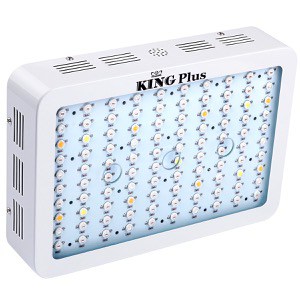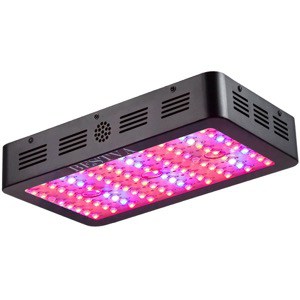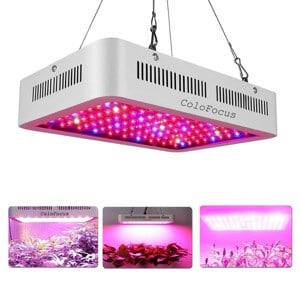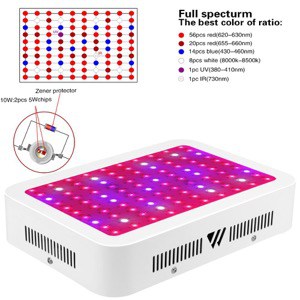Top 4 Best 1000 Watt LED Grow Light of 2023
There are many business houses who are entering into the world of LED lightning. The cannabis yield is large but the electricity charge is low. Let us know why the marketers are switching towards LED lights:
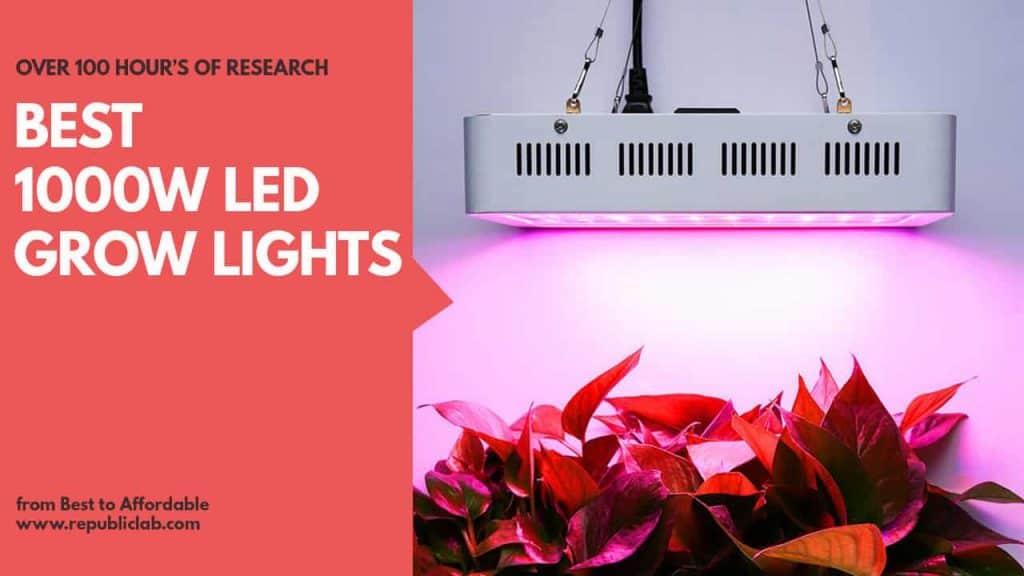
Difference Between LED and HID
Light emitting diode or LED lights make use of electricity more efficiently as compared to other technologies like HID bulbs (high intensity discharge). They will cost you very less even if you run them for over time.
A full spectrum of LED panel is a better choice in case of growing cannabis as their light resembles to natural sunlight with a cost equal to the fraction cost of glowing HID lamps.
Best 1000 Watt LED Grow Lights - Top 4
1. King plus 1000 W grow light
It consists of 10W LED bulbs with double chips. These are brighter and more efficient as compared to traditional 5W or 3W LEDs. They are scientifically engineered so as to keep a balance between coverage area and lumen output/PAR.
Key Features
It has a longer life span. It consumes only 185W of power, thus saves your energy consumptions.
It just consumes 0.185KWh every hour and therefore saves money more than MH/HPS lamps.
It works worldwide with a voltage of 85V-265V. Just plug it and play. It has a full spectrum with white, yellow, blue, red, UV and IR which are similar to the colors of sunlight.
It is termed ideal for all indoor flowers, vegetables and plants at all stages of their growth. It has an excellent cooling system. It consists of small holes on its LED board along with glass convection through fans.
There is efficient dissipation of heat. Every LED keeps on working separately. The company has its own factory and has professionals to develop, design and research on the products.
The company provides customer services professionally and is available 24X7. It is available at its best price on Amazon. Also it provides you with 3 years warranty.
PROS
- Own factory outlet
- Fantastic cooling system
- Full spectrum
- Energy saving
- Double chip 10W lights
CONS
- Bulb aren't 100% reliable.
- Light won't be as good for 50,000 hours as claimed.
2. Bestva 1000W double chip
The 10W Dual Chip LEDs are much efficient and brighter than the traditional 5W and 3W LEDs. It has the highest lumen output/ PAR on each LED.
Key Features
1000W full spectrum grow lights have proven out to be very beneficial to indoor flowers, vegetables and plants.
It looks like a natural sunshine. Its strong fan cooling system is noise free and very cool as compared to other lights of this range.
Its glass makeover and holes on its aluminum panel make the heat convection run at approximately 50-60 degree F which is again lower than other similar lights.
If we compare it with 600W HPS lights, it will only consume 185W. Its coverage area is twice than any other reflector light. It is regarded perfect for an area of 5.1’X4.7’. Its ideal height of placing is 24”.
The manufacturer gives you warranty of three years along with a return policy of 30 days if unsatisfied with the product.
PROS
- Dual chip technology
- Full spectrum
- Better coverage area
- Attractive returns and replacement policies
CONS
- For indoor use only. Not Waterproof
- Extremely powerful. Can be harmful if watched directly.
3. Colo Focus 1000W Double Chips Indoor LED
It has powerful lights of 1000W. Each LED contains 2 pieces of 5W making it double chipped LED which is more efficient and brighter than 5W and 3W LEDs.
It is a great energy saver as it just consumes 110W-120W power. The brightness is very high and has a long Lifespan.
Key Features
The UV technology sterilizes the growth of bacteria which may hinder the plant’s growth and its ability to produce healthy flowers.
Its IR function improves cell division and promotes growth in flowering and vegetation phases. This will increase the yield to some extent.
Its professional spectrum is developed after eight years of research of an experienced manufacturer.
Its light resembles to natural sunlight which is beneficial for both flowering as well as non flowering plants in their overall growth stages.
Two fans for cooling are placed in its every kit for protection from overheat. This keeps the lights in working for longer hours.
PROS
- Powerful double chip lights
- UV function
- Professional spectrum
- Overheat protection
CONS
- No Cons
4. Morsen LED Grow Light
Key Features
Its bright double LEDs are highly efficient in growing season of the plants. It has greatly replaced MH/HPS/HID lights in case of energy saving.
It actually consumes a power of just 185W which automatically saves energy to a great extent.
The full spectrum of red lights 630nm-660nm, orange lights 590nm-610nm, blue lights 430nm-470nm, IR of 730nm, white lights 6500K-3500K, UV of 380nm.
These bring proper wavelengths that are necessary for the plants both at blooming as well as growing stage.
It is widely useful in greenhouses, tissue culture, spraying, potted plants, farm, pipeline cultivation, water breeding, indoor gardens, flower farming and many more.
PROS
- 10W double chipped LEDs
- Low power consumption
- Full spectrum lightning
CONS
- No Cons
Things To Consider Before Choosing a Grow Light
While buying 1000 Watt LED grow light, we need to take consideration of the area we want to cover and intensity of light we require for our purpose. To go in detail there are many aspects that should be taken care of when you buy a plant light. All of them are discussed below:
ACTUAL WATTAGE
It refers to the actual capacity used by the fixtures. Two lights mentioned below have a same wattage whereas the other two have different ranges. This is done so to give you control over spectrum.
At the time of vegetative age of the plant, plants do not require much light as much they need during flowerings. Your electricity cost will be saved if you let your fixture to automatically turn off the LEDs.
SPECTRUM:
While analyzing right spectrum for our LED light, We need to consider 2 factors here.
A. The Color of Light
B. The customization Options in Light
A. The Color of Light: Colored LEDs vs. White LEDs
Fixtures with colored LEDs also have a few white LEDs mixed in them. But only white colored LEDs are used in Next Light Mega.
Here are two sides of white colored lights:
A.1) Favour of white light
Proponents of white grow light say that their spectrum is most natural as it is similar to sunlight. Its light is similar to a HPS bulb also when run with a halide metal bulb. Or we can refer it as a HPS spectrum together with an additional light of blue color.
HPS has proved out to be the best for working with the plants. Also we know that plants love sunlight, so white LED is the best option to go for it. Also it works similar to MH and HPS lights.
Also there is another advantage of white light i.e. the plants look natural in white light, so it becomes easier to inspect and notice any sort of discolorations in them which is difficult in case of pink lights.
A.2) Against use of white light
Opponents of this light has pointed out that it is actually made of yellow and green light which is a little used by the plants and generally gets wasted. It is ok in case of sun as it is an inexhaustible source of energy and is free of cost too. But in case of LEDs you are just footing your bill by wasting light.
B. The Customization Options in Light
There are separate modes each for bloom and veg in few lights. For example, Cirrus T allows you to keep a complete control on the spectrum.
The basic advantage is- lower electricity cost. Plants need more of the light in flowering and not during vegging. Even during cloning too, there is no requirement of enough lights. So you can dial back the right amount of light as per the usage so as to avoid wastage of electricity.
But there is also flip side of it. If you change the colour of lights during mid growth, plants may get shocked and could suffer from stalling growth for nearly two weeks. The switching modes in LEDs, will not create the problem of stalled growth for long but you should be prepared for a few days to face it.
For that time, you have to pay your electricity bills for running lights and for obtaining nutrients, needed to feed plants. Also, fixtures with one mode are easy to operate. Just you need to turn that and forget it.
Light output
1000W LEDs usually have an output similar to 900W in an HPS light device. 4 star ratings are given to fixtures of intensity 900HPS and 5 star ratings for fixtures with intensity of 1000W HPS technology bulbs. Cirrus T5000 is the most powerful device than rest of the three as it gives 1200W light.
Canopy penetration
All the manufacturers claim that their LEDs penetrate below canopy as in case of HPS lights. But in reality, the case is very rare. 5 stars are given who penetrate equivalent to HPS and 4 to those who penetrate a little less than HPS.
Area Of Coverage
For choosing a glow light, specs should be ignored. Lumens are used for measuring the brightness of human eyes. More attention should be paid to specs like wattage and PAR along with the guidelines put by the manufacturer on the coverage.
PAR (photosynthetically active radiation) is emitted by the colors as well as the light’s intensity. Bright lights with a broad spectrum can thrive your cannabis better. PAR can measure lights of 400-700nm in the spectrum. It emerges into blue and ends up as red and finally as infrared.

